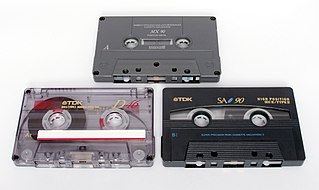
Computer data storage or digital data storage is a technology consisting of computer components and recording media that are used to retain digital data. It is a core function and fundamental component of computers.

Duct tape is cloth- or scrim-backed pressure-sensitive tape, often coated with polyethylene. There are a variety of constructions using different backings and adhesives, and the term "duct tape" has been genericized to refer to different cloth tapes with differing purposes. A variation is heat-resistant foil tape useful for sealing heating and cooling ducts, produced because the adhesive on standard duct tape fails and the synthetic fabric reinforcement mesh deteriorates when used on heating ducts.

The Compact Cassette, also commonly called a cassette tape, audio cassette, or simply tape or cassette, is an analog magnetic tape recording format for audio recording and playback. Invented by Lou Ottens and his team at the Dutch company Philips, the Compact Cassette was released in August 1963.

An audio tape recorder, also known as a tape deck, tape player or tape machine or simply a tape recorder, is a sound recording and reproduction device that records and plays back sounds usually using magnetic tape for storage. In its present-day form, it records a fluctuating signal by moving the tape across a tape head that polarizes the magnetic domains in the tape in proportion to the audio signal. Tape-recording devices include the reel-to-reel tape deck and the cassette deck, which uses a cassette for storage.

Reel-to-reel audio tape recording, also called open-reel recording, is magnetic tape audio recording in which the recording tape is spooled between reels. To prepare for use, the supply reel containing the tape is placed on a spindle or hub. The end of the tape is manually pulled from the reel, threaded through mechanical guides and over a tape head assembly, and attached by friction to the hub of the second, initially empty takeup reel. Reel-to-reel systems use tape that is 1⁄4, 1⁄2, 1, or 2 inches wide, which normally moves at 3+3⁄4, 7+1⁄2, 15 or 30 inches per second. Domestic consumer machines almost always used 1⁄4 inch (6.35 mm) or narrower tape and many offered slower speeds such as 1+7⁄8 inches per second (4.762 cm/s). All standard tape speeds are derived as a binary submultiple of 30 inches per second.

Digitization is the process of converting information into a digital format. The result is the representation of an object, image, sound, document, or signal obtained by generating a series of numbers that describe a discrete set of points or samples. The result is called digital representation or, more specifically, a digital image, for the object, and digital form, for the signal. In modern practice, the digitized data is in the form of binary numbers, which facilitates processing by digital computers and other operations, but digitizing simply means "the conversion of analog source material into a numerical format"; the decimal or any other number system can be used instead.

GlassBridge Enterprises, Inc., formerly Imation Corporation, is an American holding company. Through its subsidiary, Glassbridge focuses primarily on investment and asset management.

In digital recording, an audio or video signal is converted into a stream of discrete numbers representing the changes over time in air pressure for audio, or chroma and luminance values for video. This number stream is saved to a storage device. To play back a digital recording, the numbers are retrieved and converted back into their original analog audio or video forms so that they can be heard or seen.

Linear Tape-Open (LTO), also known as the LTO Ultrium format, is a magnetic tape data storage technology used for backup, data archiving, and data transfer. It was originally developed in the late 1990s as an open standards alternative to the proprietary magnetic tape formats available at the time. Upon introduction, LTO rapidly defined the super tape market segment and has consistently been the best-selling super tape format. The latest generation as of 2021, LTO-9, can hold 18 TB in one cartridge.

Scotch is a brand name used for tape and related products developed by 3M. It was first introduced by Richard Drew, who created the initial masking tape under the Scotch brand. The invention of Scotch-brand cellulose tape expanded its applications, making it suitable for sealing packages and conducting item repairs. Over time, Scotch tapes have been utilized in various industries and households for its diverse adhesive solutions.

Electronic article surveillance (EAS) is a type of system used to prevent shoplifting from retail stores, pilferage of books from libraries, or unwanted removal of properties from office buildings. EAS systems typically consist of two components: EAS antennas and EAS tags or labels. EAS tags are attached to merchandise; these tags can only be removed or deactivated by employees when the item is properly purchased or checked out. If merchandise bearing an active tag passes by an antenna installed at an entrance/exit, an alarm sounds alerting staff that merchandise is leaving the store unauthorized. Some stores also have antennas at entrances to restrooms to deter shoppers from taking unpaid-for merchandise into the restroom where they could remove the tags.

Magnepan is a private high-end audio loudspeaker manufacturer in White Bear Lake, Minnesota, United States. Their loudspeaker technology was conceived and implemented by engineer Jim Winey in 1969.

Laurence Earl Crosby was the long-serving publicity director of his younger brother, Bing Crosby, a manager, a philanthropist, an inventor and an author. He was the eldest of Bing's six siblings.

9-track tape is a format for magnetic-tape data storage, introduced with the IBM System/360 in 1964. The 1⁄2 inch (12.7 mm) wide magnetic tape media and reels have the same size as the earlier IBM 7-track format it replaced, but the new format has eight data tracks and one parity track for a total of nine parallel tracks. Data is stored as 8-bit characters, spanning the full width of the tape. Various recording methods have been employed during its lifetime as tape speed and data density increased, including PE, GCR, and NRZI. Tapes come in various sizes up to 3,600 feet (1,100 m) in length.

DC100 is a tape cartridge format that was co-developed by Hewlett-Packard and 3M. Introduced in mid-1976, it was developed as a data storage mechanism for the HP 9820 programmable calculator. The DC100 tape cartridge was a scaled-down version of the DC300 cartridge pioneered by 3M, and represents an early version of what is now referred to as the QIC Mini Cartridge. 3M was the exclusive source of DC100 tapes, while drives were manufactured by 3M and several third parties.
Magnetic-tape data storage is a system for storing digital information on magnetic tape using digital recording.

3M Company is an American multinational conglomerate operating in the fields of industry, worker safety, and consumer goods. Based in the Saint Paul, Minnesota, suburb of Maplewood, the company produces over 60,000 products, including adhesives, abrasives, laminates, passive fire protection, personal protective equipment, window films, paint protection film, electrical, electronic connecting, insulating materials, car-care products, electronic circuits, and optical films. Among its best-known consumer brands are Scotch Tape, Scotchguard surface protectants, Post-it notes, and Nexcare adhesive bandages. 3M’s stock ticker symbol is MMM and is listed on the New York Stock Exchange, Inc. (NYSE), the Chicago Stock Exchange, Inc., and the SIX Swiss Exchange.

Preservation of magnetic audiotape comprises techniques for handling, cleaning and storage of magnetic audiotapes in an archival repository. Multiple types of magnetic media exist but are mainly in the form of open reels or enclosed cassettes. Although digitization of materials on fragile magnetic media in library and information science is a common practice, there remains a need for conserving the actual physical magnetic tape and playback equipment as artifacts.
Tape or Tapes may refer to:
The term digital card can refer to a physical item, such as a memory card on a camera, or, increasingly since 2017, to the digital content hosted as a virtual card or cloud card, as a digital virtual representation of a physical card. They share a common purpose: identity management, credit card, debit card or driver's license. A non-physical digital card, unlike a magnetic stripe card, can emulate (imitate) any kind of card.


















